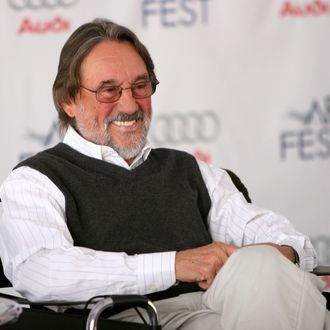
Last year, the Hungarian cinematographer Vilmos Zsigmond told Filmmaker Magazine, “I think film is about images. Cinema needs good images. I think that if you don’t have good images, it’s not going to be a film.” Directors, he said, focused too much on words — talk, talk, talk, not enough on images. True to his manifesto, Zsigmond shot some of the most indelible cinematic images of the 1970s and 1980s, from musical aliens hovering majestically over Moocraft, Wyoming, to cowboys dancing in gauzy washes of light.
Zsigmond, who died on New Year’s day at the age of 85, escaped from Hungary in 1956 with his friend László Kovács (the cinematographer for Dennis Hopper’s iconic 1969* counter-culture odyssey Easy Rider, as well as Ghostbusters in 1984). Their luggage was filled with long ribbons of newsreel footage they had shot on the streets of Budapest. They sold their film to CBS, which impelled their careers as documentary cameramen. For most of the ’60s Zsigmond worked on claptrap and exploitative trash (check out The Incredibly Strange Creatures Who Stopped Living and Became Mixed-Up Zombies, from 1964 – it’s a hoot). He was hired, thanks to a heartfelt recommendation from Kovács, to shoot Robert Altman’s revisionist western McCabe & Mrs. Miller in 1971, which was the cinematographer’s first masterpiece. He mingled the dirty, dusty sense of detached realism he had honed in Budapest with lyricism, making prolific use of a zoom lens (which would become an Altman staple), and giving flurries of snow the taciturn feeling of so much opium drifting through a Midwest winter. The film received rave reviews, particularly from The New Yorker’s Pauline Kael.
Zsigmond then worked on Altman’s neo-noir The Long Goodbye (1973), which did middling business, but, like most of Altman’s movies, accrued a legion of followers in subsequent years. He won an Oscar for Steven Spielberg’s milestone Close Encounters of the Third Kind (1977), the film in which Spielberg began to prominently play with light as a spectral, almost tangible entity. It pours in red streams through keyholes and, in one of American cinema’s most immediately identifiable images, swallows trucks on forlorn highways. Zsigmond was nominated for another Oscar, and won a BAFTA, for Michael Cimino’s The Deer Hunter (1978). Cimino’s follow-up, the nearly four-hour epic western Heaven’s Gate (1980), notoriously flopped, destroying a production company, and Cimino’s career, in the process. The film, for which Cimino and Zsigmond shot 1.3 million feet of film, is now an accepted classic, the valediction of New Hollywood and, as Roger Ebert’s Scout Tafoya put it, an examination of nostalgic naivety, suffused with technology and the smog it produces. Zsigmond’s work — vast swaths of light draped across dusty rooms and an immersive sense of size — showcases a trick or two culled from his time with Spielberg.
While his work with Spielberg and Cimino is his most acclaimed, Zsigmond’s greatest partner in crime was Brian De Palma, the most purely cinematic filmmaker of the last half-century, for whom the cinematographer did some of his finest, most innovative work. De Palma’s films are not governed by the rules or laws of reality; they adhere to a consistent, internal logic that favors excitement over emotion. Zsigmond extrapolated De Palma’s deep-rooted love for genre and exploitation, and helped the auteur construct his homage-laden films using the visual language written by earlier filmmakers. Together they were like a jazz duo drawing inspiration from their forebears, carving out pulp scenes of brilliance and brutality. They employed an arsenal of in-camera tricks, from split-diopters to long Steadicam shots and meticulous use of zooms. Zsigmond shot Obsession (1978), a fervid Hitchcock homage, and Blow Out (1981), a contender for De Palma’s Best Film. For Blow Out, Zsigmond and De Palma deconstructed the art of filmmaking, reveling in the minutiae of filming and editing and spinning a story of paranoia and murder out of so many reels of celluloid.
Zsigmond’s final masterpiece, and one of his most impressive achievements, is also one of De Palma’s most maligned films: The Black Dahlia (2006), which Zsigmond considered the last good film he worked on. A mostly faithful adaptation of James Ellroy’s serpentine novel (it retains the terse dialogue while carefully uncoiling the notoriously difficult-to-follow plot), there’s nary a shot here that doesn’t get the De Palma touch: The camera looms and moves with purpose, zooming in, pulling out, hovering above a dead body splayed on a slab before slowly descending to a low-angle of our heroes framed against effervescent lights, or a crane shot showing the Zoot Suit riots sprawling across streets lined with burning cars and sprinkled with so much broken glass. The narrative is, admittedly, of minimal importance here, as is De Palma’s and Zsigmond’s wont; the director fixates on the mood, which his DP captured with stunning, sepia-steeped photography. If that isn’t a fine encapsulation of Zsigmond’s endearing legacy, then nothing is.
*This article originally stated a different release year for Easy Rider. We regret the error.

